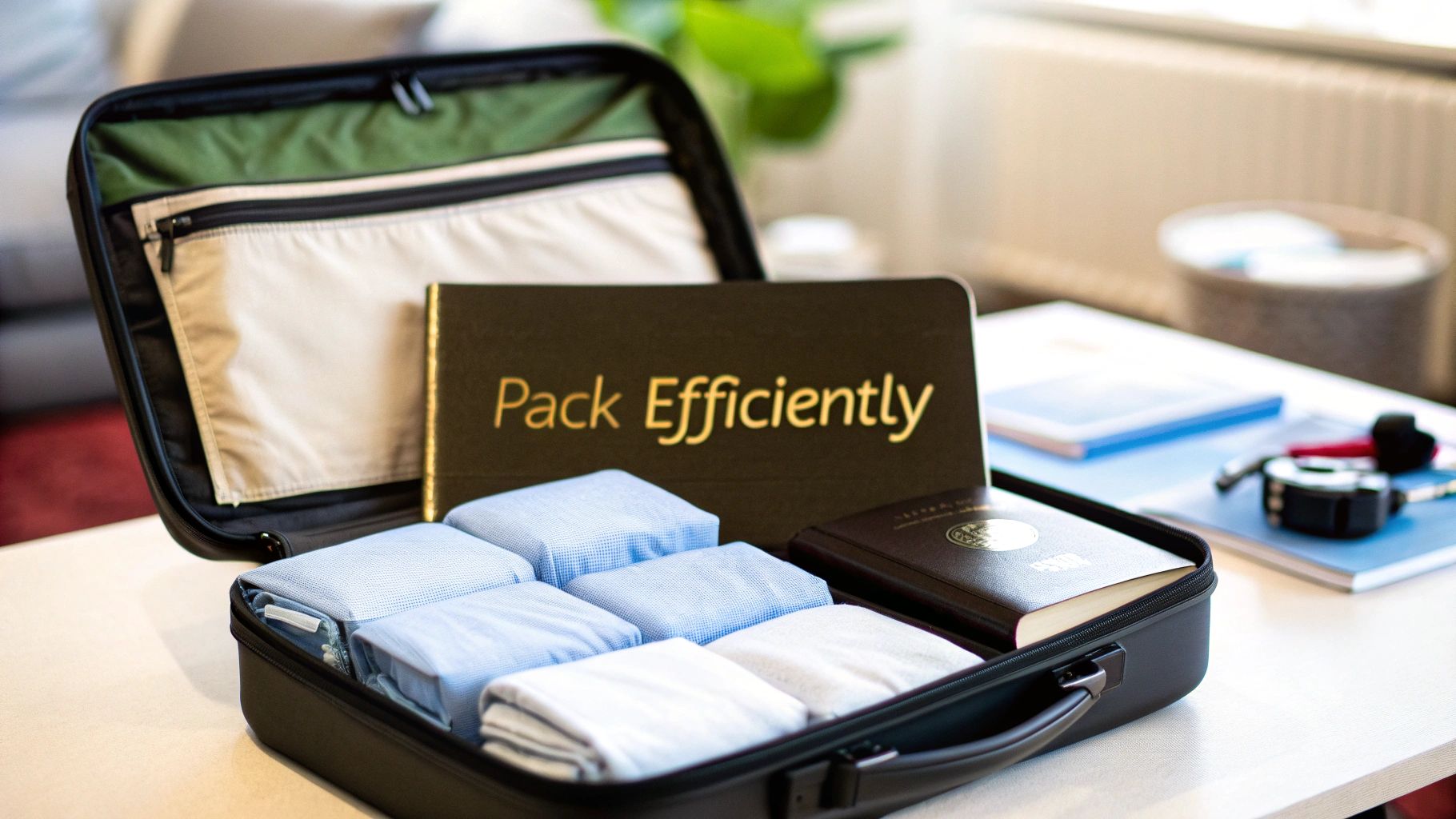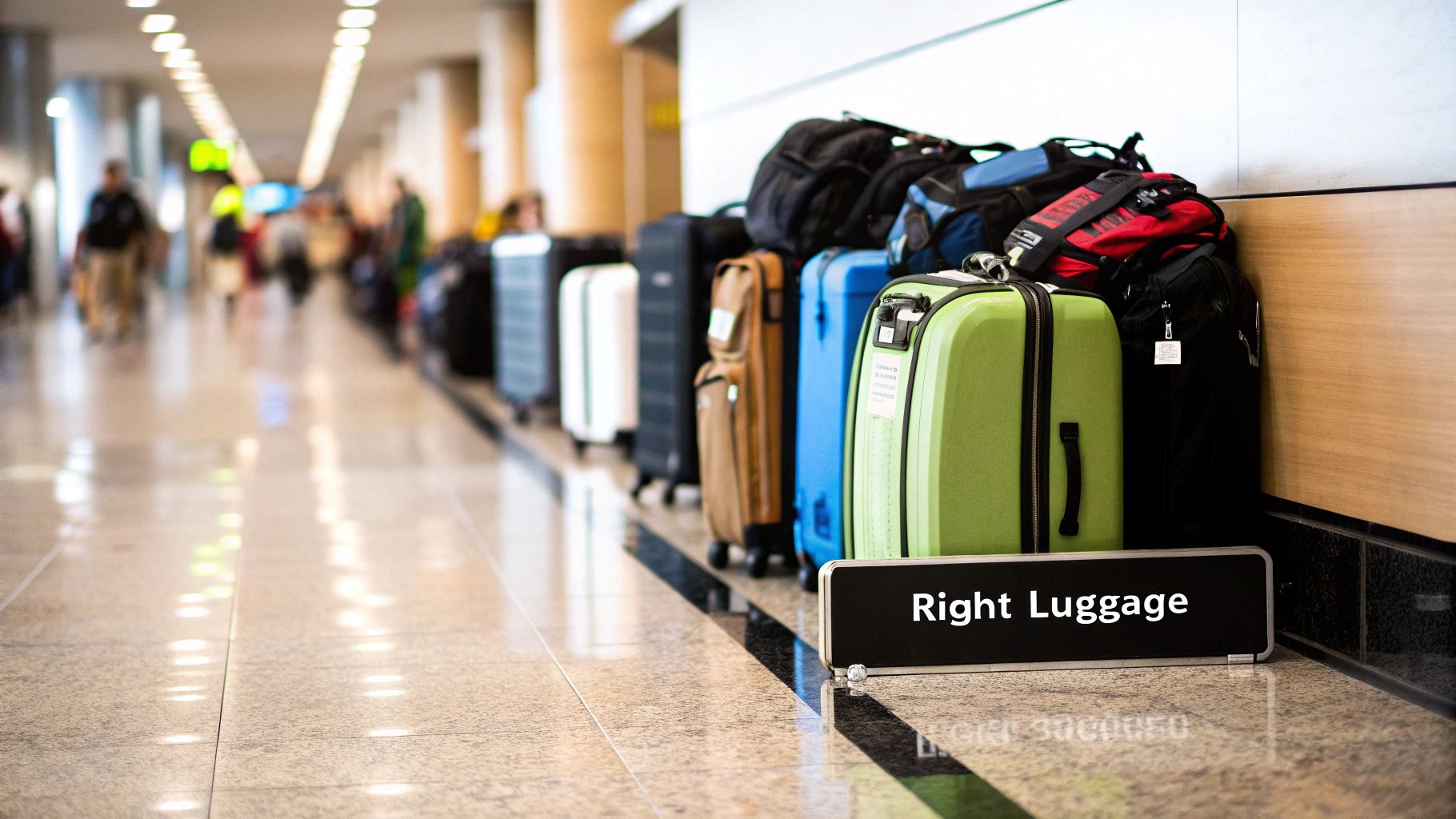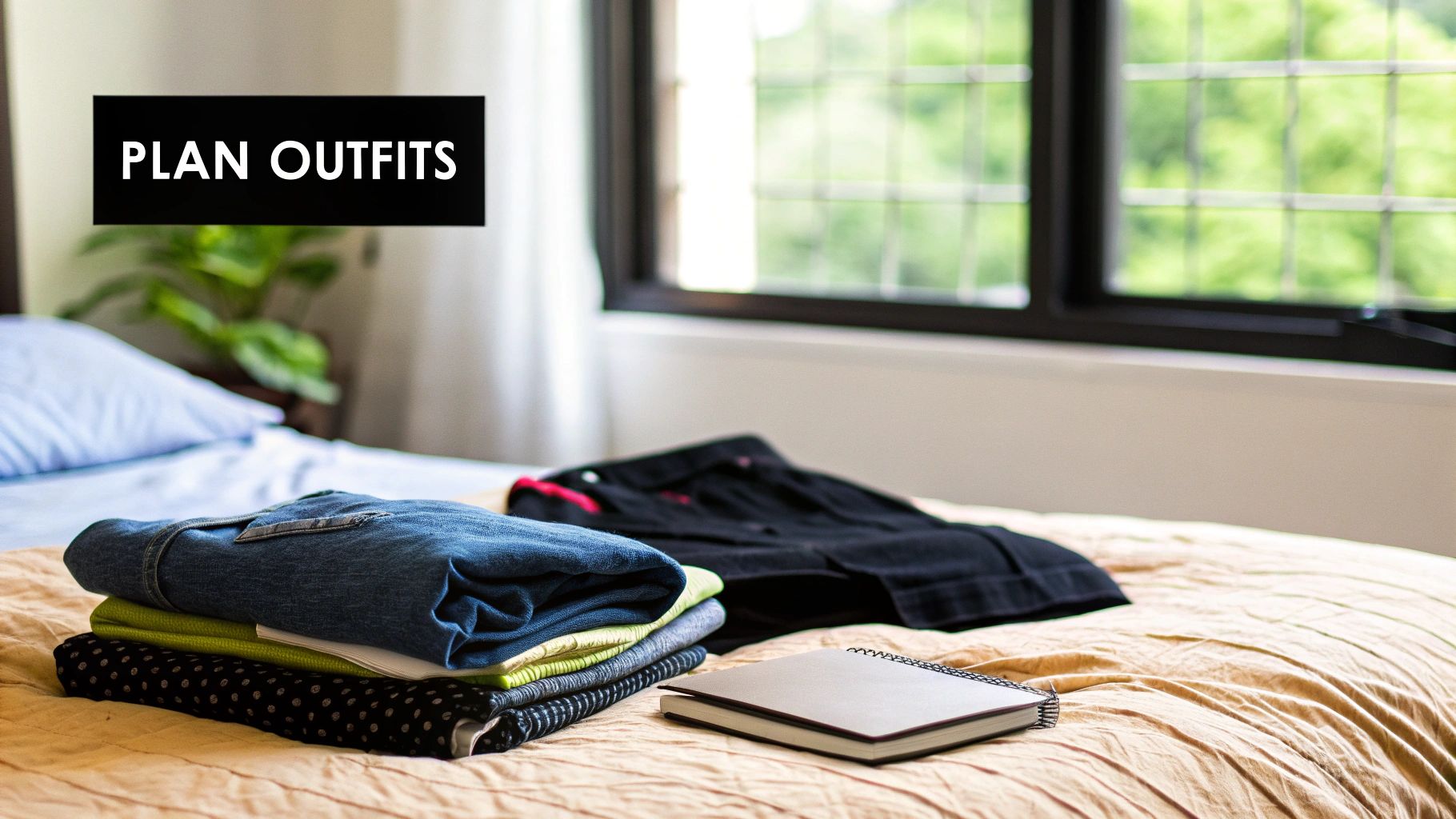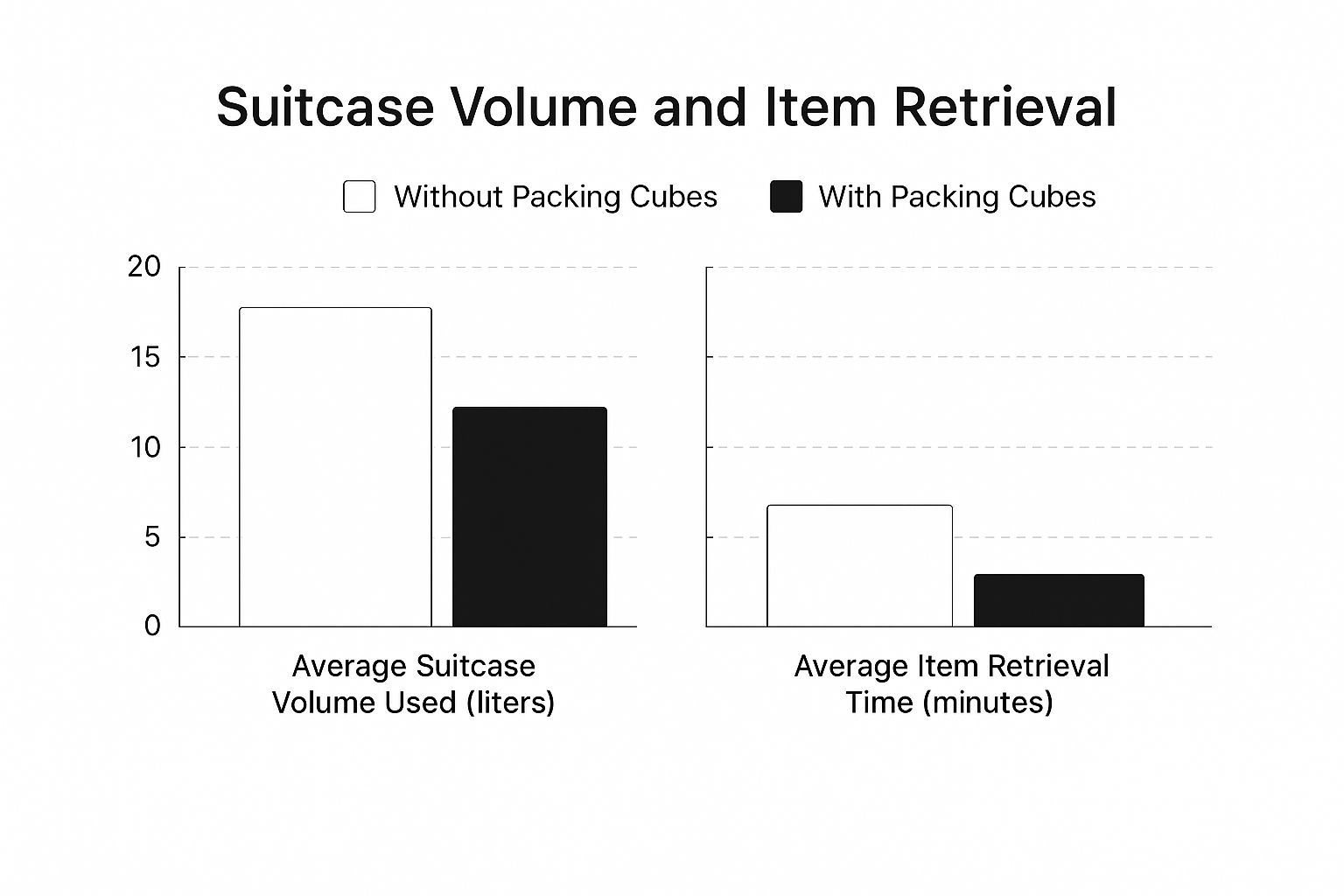
Why Mastering Efficient Packing Transforms Your Travel

Packing: it's often the most dreaded part of preparing for a trip. But what if packing could be more than just cramming clothes into a suitcase? Mastering efficient packing can fundamentally change your travel experience, impacting everything from your budget to your overall enjoyment. Imagine arriving at your destination feeling refreshed and ready to go instead of stressed and overwhelmed. That's the power of smart packing.
Less Stress, More Exploration
One of the biggest advantages of efficient packing is reduced travel anxiety. Knowing what you've packed and where to find it eliminates the frantic search through overstuffed bags. This organized approach leads to a smoother airport experience, minimizing baggage claim hassles and maximizing your precious vacation time. Plus, lighter luggage makes navigating crowded streets and public transportation much easier.
The Financial Perks of Packing Light
Efficient packing can also save you money. By minimizing checked bags, you can avoid hefty baggage fees. These fees can add up quickly, especially for families. Some airlines charge upwards of $30 per checked bag, each way. This means efficient packing for a round-trip could save you $60 or more. That's extra cash for souvenirs or a nice dinner at your destination. For more packing tips, check out this helpful guide: How to Pack Efficiently for Moving.
Efficiency and Sustainability
Packing light is also a more sustainable way to travel. Overpacking contributes to higher fuel consumption due to the increased weight on airplanes and other modes of transport. By packing only what you need, you’re reducing your environmental impact. This mindful approach can extend to choosing reusable packing cubes and minimizing single-use plastics. Thinking about packing efficiency also ties into larger global trends in the packaging industry. The global packaging market is expected to grow from $917 billion in 2019 to $1.05 trillion in 2024. This highlights the increasing demand for efficient packaging solutions across various sectors. Reducing waste and cost are key concerns, and efficient packing plays a crucial role. Learn more about these industry trends: 2023 Global Packaging Industry Report. You can also explore more packing tips: How to master...
From reducing stress and saving money to promoting sustainability, efficient packing offers numerous benefits. It sets the stage for a more relaxed, enjoyable, and responsible travel experience.
The Packing Arsenal: Tools That Actually Make a Difference

We've covered the reasons behind efficient packing. Now, let's explore the practical side—the essential tools that can truly upgrade your packing process. Choosing the right luggage and accessories isn't about splashing out on the most expensive items. It's about investing wisely in versatile tools that will simplify your packing for many trips to come.
Luggage: Choosing Your Travel Companion
Efficient packing starts with the right luggage. The first step is understanding the key differences between hard-shell and soft-sided suitcases. Hard-shell luggage provides robust protection for fragile items but can be less adaptable when fitting into tight spaces. Soft-sided luggage, on the other hand, offers expandability and is often lighter, perfect for maximizing packing space and maneuvering in crowded areas.
Wheel type is another important consideration. Spinner suitcases, with their four multi-directional wheels, allow for easy movement, especially in busy airports. However, two-wheeled luggage tends to be more durable and offers better stability on uneven terrain. The best choice depends on your usual travel style and the types of destinations you frequent.
Compression Cubes: Your Secret Weapon
Compression cubes have evolved from a luxury item to a packing essential. These clever fabric containers allow you to organize clothing and compress items, significantly maximizing space. Rolling clothes instead of folding not only saves space but also reduces wrinkles. Think of it as a packing puzzle: efficiently fitting more pieces into the same area.
Organizational Accessories: Small Tools, Big Impact
Along with compression cubes, a range of other organizational accessories can significantly boost your packing efficiency.
- Packing folders: Keep clothes neatly folded and wrinkle-free, particularly beneficial for business attire.
- Shoe bags: Protect your clothes from dirty shoes and contain any odors.
- Toiletry bags: Opt for leak-proof options with compartments to keep toiletries organized and secure.
These small additions can make a significant difference in how much you can pack and how easy it is to find items during your travels. This focus on organization extends to various industries, such as paper production. In 2023, global paper and paperboard production reached 401 million metric tons. Efficient packing and the use of recyclable and biodegradable materials are critical in this sector to minimize waste. Learn more: Global Paper and Cardboard Production. This highlights how the principles of efficient packing apply across diverse fields.
To help you choose the right packing materials, take a look at the comparison table below:
Packing Materials Comparison: Comparison of different packing materials with their pros, cons, and best use cases
| Material | Weight | Durability | Cost | Eco-Friendliness | Best For |
|---|---|---|---|---|---|
| Plastic Wrap | Lightweight | Low | Low | Not Eco-Friendly | Protecting items from moisture |
| Bubble Wrap | Lightweight | Medium | Low | Not Eco-Friendly | Cushioning fragile items |
| Packing Peanuts | Lightweight | Low | Low | Not Eco-Friendly | Filling empty spaces |
| Paper | Lightweight | Low | Low | Eco-Friendly | Wrapping small items |
| Cardboard | Medium | High | Medium | Eco-Friendly | Protecting larger items |
| Fabric/Textiles | Medium | Medium | Medium | Can be Eco-Friendly (depending on material) | Wrapping delicate items |
This table summarizes the characteristics of various packing materials, helping you select the optimal choice for your needs. Choosing wisely contributes to both efficient packing and environmental responsibility.
By carefully choosing the right luggage and incorporating useful accessories, you create a personalized packing system. This streamlines your packing process and paves the way for a more enjoyable travel experience. The next step is mastering the art of packing techniques themselves.
Roll, Fold, Bundle: Techniques That Actually Save Space

This infographic demonstrates how packing cubes impact both suitcase volume and the time it takes to retrieve items. Using packing cubes can significantly reduce the space your clothes take up, and make finding what you need much faster. Packing cubes can decrease suitcase volume by 25% (from 20 liters to 15 liters) and cut item retrieval time by more than half. This data highlights how the right techniques and tools can greatly improve packing efficiency. Let's explore some specific packing strategies.
Rolling vs. Folding: The Great Debate
Should you roll or fold your clothes? While folding is the traditional method, rolling can be surprisingly effective, particularly for softer items like t-shirts, jeans, and casual wear. Tightly rolled clothes form compact cylinders that maximize space and minimize wrinkles. For stiffer fabrics like dress shirts and blazers, however, folding is still the best way to maintain their shape and reduce creasing.
The Bundling Method: Wrinkle-Free Business Attire
Business travelers will appreciate the bundling method for keeping clothes wrinkle-free. This technique involves wrapping garments around a central core, such as a small pouch of socks or underwear, to create a compact bundle. The outer layers protect the inner clothing, preventing creases and wrinkles. Bundling works particularly well for suits, dresses, and other formal wear.
Compression Techniques: Maximizing Space
Compression is essential for bulky items like sweaters and jackets. Compression cubes or even large zip-top bags can reduce the volume of these items by up to 60%, creating valuable extra space in your luggage. This space-saving principle is similar to how packing cubes create greater organization and efficiency, as shown in the infographic above.
Specialized Approaches for Tricky Items
Efficient packing involves tailoring your techniques to specific items. For example, placing socks and underwear inside shoes maximizes space and helps the shoes retain their shape. Rolling belts and placing them inside shirt collars also saves space and prevents them from bending or cracking.
To further illustrate effective packing techniques, let's examine a comparison of various methods:
Introduction to Table: The following table compares the effectiveness of different clothing packing techniques, focusing on space saved, wrinkle prevention, ease of use, and ideal clothing types.
| Technique | Space Saving % | Wrinkle Prevention | Ease of Use | Best For Clothing Types |
|---|---|---|---|---|
| Rolling | High (20-30%) | Moderate | Easy | Casual clothes, jeans, t-shirts |
| Folding | Moderate (10-20%) | High | Easy | Dress shirts, blazers, formal wear |
| Bundling | High (25-35%) | Excellent | Moderate | Suits, dresses, delicate items |
| Compression | Excellent (up to 60%) | Low | Moderate | Bulky items like sweaters and jackets |
Conclusion of Table: As the table shows, each packing method offers different benefits. Rolling is great for casual clothes, folding is ideal for formal wear, bundling excels at wrinkle prevention, and compression is perfect for bulky items. Choosing the right technique depends on the specific clothing and your packing priorities.
- Formal wear: Use garment bags and tissue paper to protect delicate fabrics and prevent wrinkles.
- Hiking boots: Clean them thoroughly and use the inside space for socks or small items.
- Oddly-shaped gear: Consider packing organizers or dry bags to compartmentalize and protect these items.
By combining rolling, folding, bundling, and compression, you can create a highly efficient packing system. This adaptable strategy allows you to maximize space and minimize wrinkles, making it a recommended approach for any packing scenario.
Building Your Personalized Packing System

We've explored the tools and techniques that make packing efficient. Now, let's discuss creating a personalized packing system that eliminates the guesswork from packing for any trip. This involves transitioning from haphazard packing to a structured, personalized approach.
Category-Based Organization: The Key to Stress-Free Packing
Organizing your belongings by category is essential for efficient packing. This method significantly reduces the risk of forgetting important items and simplifies unpacking. Imagine easily finding your toiletries, electronics, or specific clothing without digging through a messy suitcase. This is the benefit of category-based packing.
For example, use separate packing cubes or compartments for shirts, pants, underwear, and toiletries. This organized system also allows for quick checks of what you've packed and what might be missing.
Adaptable Packing Lists: Your Travel Blueprint
A master packing list is the foundation of any efficient packing system. However, this list shouldn't be fixed. Learn to create adaptable packing lists that you can easily modify for different trips.
Begin with a core list of essentials, then add or remove items based on the destination, climate, and planned activities. This saves you the time and effort of starting from scratch for every trip.
You might be interested in: How to master...
Packing Sequences: Minimizing Decision Fatigue
The order in which you pack is important. A good packing sequence minimizes decision fatigue and packing stress. Consider the "first in, last out" principle. Items you'll need first, such as toiletries and a change of clothes, should be packed last for easy access.
Items you won't need until later can be packed first. This strategic approach prevents you from unpacking your entire suitcase to find a single item. Also, pack essential items first. This ensures you have the most critical things with you, even if you run out of space. This is especially helpful for carry-on only travel where space is limited. Travel expert Samantha Brown emphasizes the importance of following airline carry-on restrictions, noting that “Every airline may be slightly different and some airports are stricter than others.” She also suggests wearing your bulkiest items on the plane to save luggage space.
Digital Tools: Streamlining Your Preparation
Technology can significantly improve creating and managing your packing system. Use packing list apps or create digital templates that you can customize for each trip. Some apps even let you share packing lists with travel companions, encouraging collaborative packing and reducing the chance of anyone forgetting essential items.
Downloadable Templates: Jumpstart Your Packing
To begin your personalized packing system, consider using downloadable templates. These templates provide a starting point for different kinds of trips, from business travel and adventures to family vacations and minimalist one-bag travel.
Adapt these templates to your specific needs and preferences to create a system that fits your travel style. This gives you a reliable framework for packing efficiently, no matter where you're going.
Pack Light, Travel Right: The Sustainable Approach
Efficient packing isn't just about convenience. It’s a responsible travel choice that offers significant environmental benefits. Overpacking adds weight to vehicles, directly increasing carbon emissions and contributing to a larger carbon footprint. Mindful packing, however, aligns with sustainable travel ethics, minimizing our impact on the planet.
The Capsule Wardrobe: Maximizing Outfits, Minimizing Items
One effective strategy for efficient and sustainable packing is the capsule wardrobe. This involves choosing a small number of versatile clothing items that can be mixed and matched to create a variety of outfits. This approach significantly reduces the number of items you pack, resulting in lighter luggage and more sustainable travel. For instance, a few neutral-colored tops and bottoms combined with some brighter accessories can generate numerous outfit combinations.
Eco-Friendly Packing Materials: Reducing Waste
Choosing sustainable packing materials further enhances eco-conscious travel. Look for packing cubes made from recycled materials. Consider biodegradable alternatives to traditional plastic bags. Using reusable water bottles, toiletry containers, and shopping bags will also help reduce single-use plastics during your trip. This minimizes waste and supports responsible consumption. You might be interested in: How to master...
Responsible Packing Practices: Respecting Local Environments
Sustainable packing goes beyond simply selecting the right materials. It also involves adopting practices that respect local environments. Avoid packing prohibited or discouraged items in your destination, such as certain sunscreens that can harm coral reefs. Be mindful of waste disposal practices at your destination and try to reduce your overall consumption during your trip. Interestingly, increased awareness of efficient packing shows up in historical data on packaging materials. In the U.S., while plastic container and packaging generation rose from 27,370 tons in 1960 to 82,220 tons in 2018, recycling rates also increased substantially, from 2,870 tons to 44,330 tons in the same period. Explore this topic further: Find more detailed statistics here.
Sustainable Laundry Practices on the Go
Maintaining efficient packing on longer trips often requires doing laundry. Opt for eco-friendly laundry detergents and avoid excessive washing. Hand-washing clothes and air-drying them instead of using energy-intensive dryers can further lessen your environmental impact. These small changes contribute significantly to minimizing your travel footprint.
By embracing these strategies—from the capsule wardrobe and eco-friendly materials to responsible laundry practices—you can pack light, travel right, and contribute to a more sustainable travel future. This conscientious approach not only benefits the environment but also improves your travel experience by reducing stress and encouraging a more mindful journey.
Destination-Specific Packing Strategies That Actually Work
Generic packing advice isn't always helpful when preparing for the unique needs of different destinations. Whether it's your first trip or you're a seasoned globetrotter, understanding destination-specific packing strategies can greatly improve your travel experience, making it more efficient and enjoyable. Let's explore some tailored packing approaches for various travel scenarios.
Business Travel: Professionalism and Efficiency
For business travelers, maintaining a professional appearance while packing light is essential. Maximizing your carry-on's potential is key. Select versatile clothing in neutral colors that can be mixed and matched to create several outfits. A dark blazer, dress pants, a skirt, and a few neutral tops can be combined for various meetings and events. Using packing folders like those from Eagle Creek can help keep clothes wrinkle-free, ensuring a polished look when you arrive. Bundling techniques, as discussed earlier, are also great for wrinkle-free business attire.
Beach Vacations: Sand-Free and Stress-Free
Beach vacations present their own packing challenges. Wet swimwear and sandy gear can easily damage other items. The answer is to use waterproof bags or dry bags to separate wet items and contain the sand. A large, lightweight tote is also handy for carrying beach essentials. Quick-drying fabrics are a must for beachwear, allowing you to quickly change between swims and pack fewer items overall.
Mountain Adventures: Conquering Bulk
Packing for a mountain trip often involves bulky cold-weather gear. However, you can manage the bulk without needing extra luggage. Compression cubes are essential for reducing the volume of sweaters, jackets, and fleece layers. Layering is also key – instead of packing one heavy jacket, pack multiple thinner layers to adjust to changing temperatures.
Extended International Travel: Mastering Long-Term Packing
Extended international travel requires a balance between thorough preparation and weight restrictions. Packing efficiently for longer trips is a skill developed through practice and adaptation. A capsule wardrobe is particularly helpful for maximizing outfit options with minimal items. For environmentally conscious travelers, packing light also aligns with broader sustainable business growth strategies by reducing overall consumption.
Tips for Extended Travel
-
Laundry: Plan to do laundry during your trip. Pack quick-drying clothing and research local laundry services or hand-washing options.
-
Seasonal Changes: If your trip spans different seasons, layering is crucial. Choose items that can be easily layered to adapt to varying temperatures.
-
Electronics: International travel often involves different power standards. Pack a universal adapter and a portable power bank to charge your devices on the go. Consider travel expert Samantha Brown’s advice to check airline-specific carry-on regulations, as they “may be slightly different and some airports are stricter than others” regarding luggage size and restrictions.
Each travel scenario requires a unique packing approach. By adapting your strategy to your destination and specific needs, you'll streamline your travel experience and enjoy a smoother, more organized, and more fulfilling trip.
Ready to discover trending travel products? Explore the selection at FindTopTrends and find the perfect tools and accessories for your next adventure.










